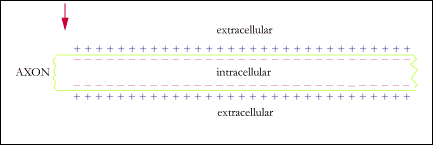 |
 |
 |
 |
 |
 |
|
|
|
Neuron anatomy
Neurons consist of a cell body which contains the nucleus of the cell, most of the cytoplasm and two different kinds of cell processes. Typical neurons have several dendrites - branching processes that conduct impulses toward the cell body, and a single axon - a long straight process that conducts impulses away from the cell body.
Axons are often referred to as nerve fibers. In most parts of the body axons are wrapped in concentric layers of the cell membrane of a cell called a Schwann cell. The wrapping, called the myelin sheath, aids impulse conduction through the axon.
Synapse
A synapse is where the branched end of an axon, the telodendron, transmits its impulse to another neuron or an effector organ such as a muscle cell across the tiny synaptic space.
When a nerve impulse reaches the end of the telodendron, it causes the release of tiny sacs of chemicals called neurotransmitters. The neurotransmitters move across the synaptic space, bind to the other cell and stimulate it. Enzymes in the synaptic space quickly inactivate the released neurotransmitter.
Nerve impulse
The cell membranes of neurons are electrically polarized at rest. Ion pumps result in the interior of the cell being about 70 millivolts negative with respect to the exterior. This polarized membrane is like a charged battery waiting to do some work.
| Axon polarity |
When a threshold stimulus is applied to the cell membrane, that site depolarizes - ions move through the cell membrane temporarily reversing the charges. Just as quickly the charges return to the original configuration and an adjacent area undergoes the same process. This reversal of charges continues to move along the membrane like a wave.
 |
Nerve impulse |